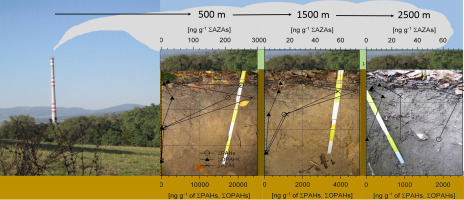Science of the Total Environment ( IF 8.2 ) Pub Date : 2018-02-20 , DOI: 10.1016/j.scitotenv.2018.02.109 Benjamin A. Musa Bandowe , Moritz Bigalke , Jozef Kobza , Wolfgang Wilcke

|
Little is known about oxygenated polycyclic aromatic hydrocarbons (OPAHs) and azaarenes (AZAs) in forest soils. We sampled all horizons of forest soils from five locations at increasing distances from an Al plant in Slovakia, and determined their polycyclic aromatic compound (PACs) concentrations. The ∑29PAHs concentrations were highest in the Oa and lowest in the Oi horizon, while the ∑14OPAHs and ∑4AZAs concentrations did not show a consistent vertical distribution among the organic horizons. The concentration ratios of PAHs and OPAHs between deeper O horizons and their overlying horizon (enrichment factors) were positively correlated with the octanol-water partition coefficients (KOW) at several locations. This is attributed to the slower degradation of the more hydrophobic PACs during organic matter decomposition. PACs concentrations decreased from the organic layer to the mineral horizons. The concentrations of ∑29PAHs (2400–17,000 ng g−1), ∑14OPAHs (430–2900 ng g−1) and ∑4AZAs (27–280 ng g−1) in the mineral A horizon generally decreased with increasing distance from the Al plant. In the A horizons, the concentrations of ∑29PAHs were correlated with those of ∑14OPAHs (r = 0.95, p = 0.02) and ∑4AZAs (r = 0.93, p = 0.02) suggesting that bioturbation was the main transport process of PACs from the organic layer into the mineral soil. At each location, the concentrations of PACs generally decreased with increasing depth of the mineral soil. Enrichment factors of PAHs in the mineral horizons were not correlated with KOW, pointing at colloid-assisted transport and bioturbation. The enrichment factors of OPAHs (in mineral horizons) at a site were negatively correlated with their KOW values indicating that these compounds were leached in dissolved form. Compared to a study 13 years before, the concentrations of PAHs had decreased in the O horizons but increased in the A and B horizons because of soil-internal redistribution after emissions had been reduced.
中文翻译:

与铝厂相对的森林土壤剖面中多环芳族化合物(PAH,氧化的PAH和氮杂)的来源和去向
对于森林土壤中的氧化多环芳烃(OPAH)和氮杂(AZA)知之甚少。我们从距斯洛伐克的一家铝厂越来越远的距离对五个地点的所有森林土壤层进行了采样,并确定了它们的多环芳族化合物(PAC)浓度。∑29PAHs浓度在Oa中最高,在Oi地平线中最低,而∑14OPAHs和∑4AZAs浓度在有机层之间未显示出一致的垂直分布。O深层和上层O层之间的PAHs和OPAHs的浓度比(富集因子)与辛醇-水分配系数(K OW)成正相关)在几个位置。这归因于在有机物分解过程中,更多疏水性PAC的降解较慢。PACs的浓度从有机层到矿物层逐渐降低。∑29PAHs(2400–17,000 ng g -1),∑14OPAHs(430–2900 ng g -1)和∑4AZA(27–280 ng g -1)的浓度)在矿物中的水平通常随着距铝厂距离的增加而减小。在A层中,∑29PAHs的浓度与∑14OPAHs(r = 0.95,p = 0.02)和∑4AZAs(r = 0.93,p = 0.02)相关,这表明生物扰动是PAC从PAC迁移的主要过程。有机层进入矿物土壤。在每个位置,PAC的浓度通常随着矿质土壤深度的增加而降低。矿物层中PAHs的富集因子与K OW无关,表明胶体辅助的运输和生物扰动。一个地点的OPAHs(在矿藏中)的富集因子与其K OW呈负相关值表明这些化合物以溶解形式浸出。与13年前的研究相比,PAHs的浓度在O层减少了,而在A和B层增加了,这是因为排放减少后土壤内部的重新分布。











































 京公网安备 11010802027423号
京公网安备 11010802027423号